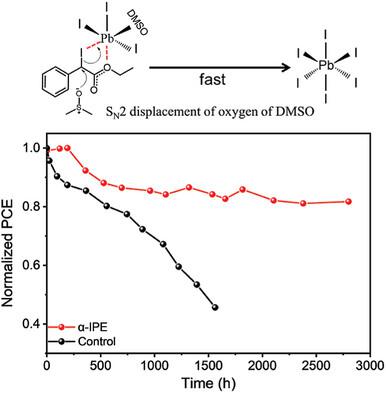当前位置:
X-MOL 学术
›
Adv. Mater.
›
论文详情
Our official English website, www.x-mol.net, welcomes your feedback! (Note: you will need to create a separate account there.)
Kornblum Oxidation Reaction-Induced Collective Transformation of Lead Polyhalides for Stable Perovskite Photovoltaics
Advanced Materials ( IF 29.4 ) Pub Date : 2024-03-26 , DOI: 10.1002/adma.202401916 Zhen Wang 1 , Xuejing Cao 1 , Heng Yang 1 , Zhiyuan Kuang 1 , Pinghui Yang 1 , Guolin Zhang 1 , Yuyang Zhang 1 , Lei Xu 1 , Daiji Zhang 1 , Sunsun Li 1 , Chunyang Miao 1 , Nana Wang 1 , Wei Huang 1, 2, 3, 4 , Jianpu Wang 1, 5
Advanced Materials ( IF 29.4 ) Pub Date : 2024-03-26 , DOI: 10.1002/adma.202401916 Zhen Wang 1 , Xuejing Cao 1 , Heng Yang 1 , Zhiyuan Kuang 1 , Pinghui Yang 1 , Guolin Zhang 1 , Yuyang Zhang 1 , Lei Xu 1 , Daiji Zhang 1 , Sunsun Li 1 , Chunyang Miao 1 , Nana Wang 1 , Wei Huang 1, 2, 3, 4 , Jianpu Wang 1, 5
Affiliation

|
The iodide vacancy defects generated during the perovskite crystallization process are a common issue that limits the efficiency and stability of perovskite solar cells (PSCs). Although excessive ionic iodides have been used to compensate for these vacancies, they are not effective in reducing defects through modulating the perovskite crystallization. Moreover, these iodide ions present in the perovskite films can act as interstitial defects, which are detrimental to the stability of the perovskite. Here, an effective approach to suppress the formation of vacancy defects by manipulating the coordination chemistry of lead polyhalides during perovskite crystallization is demonstrated. To achieve this suppression, an α-iodo ketone is introduced to undergo a process of Kornblum oxidation reaction that releases halide ions. This process induces a rapid collective transformation of lead polyhalides during the nucleation process and significantly reduces iodide vacancy defects. As a result, the ion mobility is decreased by one order of magnitude in perovskite film and the PSC achieves significantly improved thermal stability, maintaining 82% of its initial power conversion efficiency at 85 °C for 2800 h. These findings highlight the potential of halide ions released by the Kornblum oxidation reaction, which can be widely used for achieving high-performance perovskite optoelectronics.
中文翻译:

Kornblum 氧化反应诱导多卤化铅集体转化以获得稳定的钙钛矿光伏
钙钛矿结晶过程中产生的碘化物空位缺陷是限制钙钛矿太阳能电池(PSC)效率和稳定性的常见问题。尽管过量的离子碘化物已被用来补偿这些空位,但它们并不能有效地通过调节钙钛矿结晶来减少缺陷。此外,钙钛矿薄膜中存在的这些碘离子可以充当间隙缺陷,这不利于钙钛矿的稳定性。在这里,证明了通过在钙钛矿结晶过程中操纵多卤化铅的配位化学来抑制空位缺陷形成的有效方法。为了实现这种抑制,引入α-碘酮进行科恩布鲁姆氧化反应,释放卤化物离子。该过程在成核过程中引起多卤化铅的快速集体转变,并显着减少碘化物空位缺陷。结果,钙钛矿薄膜中的离子迁移率降低了一个数量级,PSC的热稳定性显着提高,在85℃下2800小时仍保持82%的初始功率转换效率。这些发现凸显了 Kornblum 氧化反应释放的卤化物离子的潜力,可广泛用于实现高性能钙钛矿光电器件。
更新日期:2024-03-26
中文翻译:

Kornblum 氧化反应诱导多卤化铅集体转化以获得稳定的钙钛矿光伏
钙钛矿结晶过程中产生的碘化物空位缺陷是限制钙钛矿太阳能电池(PSC)效率和稳定性的常见问题。尽管过量的离子碘化物已被用来补偿这些空位,但它们并不能有效地通过调节钙钛矿结晶来减少缺陷。此外,钙钛矿薄膜中存在的这些碘离子可以充当间隙缺陷,这不利于钙钛矿的稳定性。在这里,证明了通过在钙钛矿结晶过程中操纵多卤化铅的配位化学来抑制空位缺陷形成的有效方法。为了实现这种抑制,引入α-碘酮进行科恩布鲁姆氧化反应,释放卤化物离子。该过程在成核过程中引起多卤化铅的快速集体转变,并显着减少碘化物空位缺陷。结果,钙钛矿薄膜中的离子迁移率降低了一个数量级,PSC的热稳定性显着提高,在85℃下2800小时仍保持82%的初始功率转换效率。这些发现凸显了 Kornblum 氧化反应释放的卤化物离子的潜力,可广泛用于实现高性能钙钛矿光电器件。



























 京公网安备 11010802027423号
京公网安备 11010802027423号